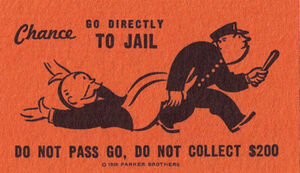Yesterday our 1st grade niece was over for a Girl's Day with my wife. The day quickly moved from arts and crafts to boardgames, primarily consisting of
Rebound. However, Uncle Frank, yours truly, was invited for a game of
Clue. I was truly honored.
Then came the dilemma. Before she became the schools librarian/media-specialist, my wife watched children in my home. Most of the kids couldn't handle playing a game unless they won...
Would this be a similar situation? I really don't want to ruin their Girl's Day - should I let our niece win to keep the peace? What would you do?
I am a firm believer in playing to win regardless of the age of your opponent. Throwing the game isn't very satisfying for you as the adult. Worse, most of the time kids can smell a rat. That doesn't mean that I bring my "A" game, but I certainly don't give the game away, either. It's about respect and honesty, in both directions, and there are right ways to win and lose with a child.
Respecting the adult. To a child, the adults in their lives are the ones who bring order and safety. As an adult, you and I are
supposed to win at games - at least games of strategy and skill. I have lost exactly two games of chess in six years of coaching the grade school chess club. Both were in situations where I was playing multiple kids at a time. The kids know how tough it is to beat me. Because I rarely lose, the kids respect my ability to teach them the game.
Respecting the child. When an adult consistently lets a child win, they are also consistently saying they don't believe the child
can win. It doesn't take long for the child to figure out what is going on and to start to believe the same thing. It's counter-intuitive, but letting them win all the time makes them believe they are losers.
Aiming to be better. It might sound trite, but letting a child win all the time means they have nothing to shoot for. The child cannot get better in a way they can measure. Now, combine that with the last point, and you have a confidence bomb: I am a loser and I cannot get better.
Having said all of this, there is a middle road. It has to do with making the right choices when playing a game with a child. Here are some ideas:
Pick the right game. There are games that children can win, even when the adult is trying their hardest. Games that are largely random are good examples. This is what has made
Candyland such a huge seller. (In fact, I can't imagine what "try your hardest" would mean with such a game!) Adults will win a little more often, because they will make better choices than children (even though choices are few and far between). Some dexterity games are good choices once the child is starting to master fine motor skills. My hands just aren't steady enough to play
Operation anymore. This does mean that you might be a couple years off from playing
Settlers of Catan, though.
Teach the game. In my chess club, everyone understands that I can win against any of them. They also understand that, if they play me, they will get instruction they would miss out on otherwise. When I am playing them, I am helping them think through the position in front of them. They can lose better when they know why they lost, and how to avoid it next time. So do I, actually.
Cooperative games. These two ideas can come together best in a cooperative game with a mixed group of adults and children. A game like
Forbidden Island puts the children in a position of not losing against adults. The children might lose against the game, but they do so with the adults they are playing with. This not only allows the adults to help the little ones and teach strategy, but also model good sportsmanship when losing.
With our niece, it worked out well. Even as a first grader, she had no problems with the rules of
Clue. She did have a little trouble with the logic and strategy involved in playing. She made a "suggestion" in the Lounge, and I showed her that I had the card for the Lounge. A few minutes later, she did it again. I could have showed her the candlestick this time, but that would have been bad play on my part. Instead, after showing her the Lounge again, I pointed out that she didn't learn any new information, and why. Of course, she went to do it a third time, but this time I reminded her that I was just going to show her the Lounge again. (That gave some additional information to my wife, but she was good enough to ignore it.) I ended up winning, though I think only because I went before my wife. She had the game solved too. Our niece was fine with losing, and I honestly think it's because she knows why she lost.
She didn't pick
Clue again, and I don't blame her. The next game was another round of
Rebound. I played, and she beat me fair and square. It was a better choice.
The day ended well; she didn't want to go home. So all of the games we played must have been a fun experience. Of course, she also painted and helped fix dinner, so it was an all around good day.
It's Your Move!





























